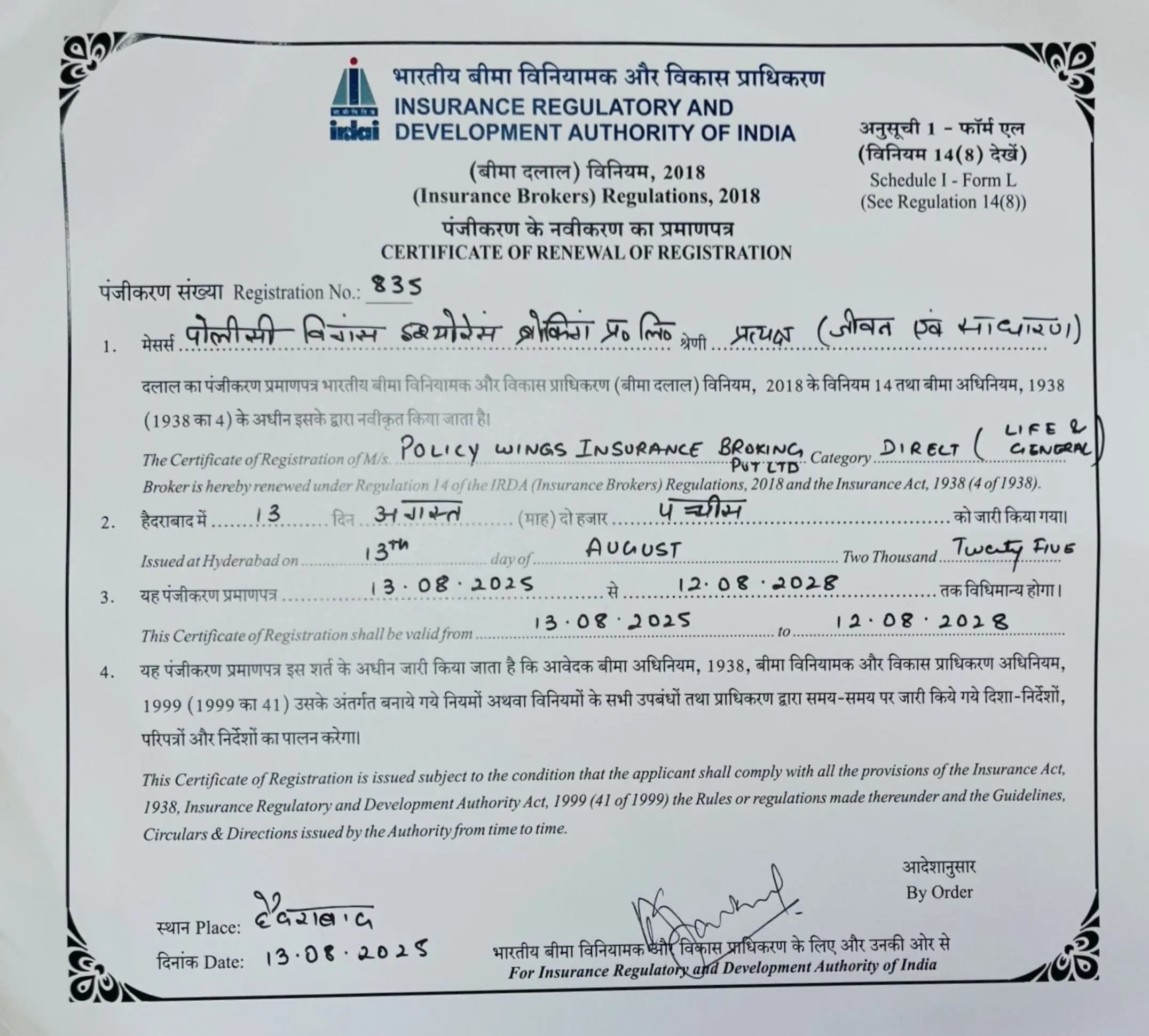Heart Attack Myocardial Infarction Insurance
Cardiovascular disease is a leading cause of death worldwide, and it can strike anyone, at any age. Having a healthy heart is the key to having a healthy life. With rising stress levels and lifestyle habits, heart diseases are on the rise. Any treatment for such a condition does not come cheap and can leave a financial strain on the patient and the family. With this in mind, it is wise to consider investing in a cardiac health insurance policy to ensure that there is no financial impact and no compromise on the treatment being given to the patient on account of the expenses.
What is cardiac health insurance?
Simply put, cardiac health insurance is a policy designed to protect your heart health. The policy covers expenses related to the diagnosis and treatment of cardiovascular disease. This can include medical procedures like angiograms, angioplasties, and bypass surgeries. Additionally, it covers medications and rehabilitation costs, making it easier for you to focus on recovery without worrying about finances.
Benefits of heart insurance policy/ critical illness insurance policy
Are you aware of the benefits of having a heart insurance policy or critical illness insurance policy? These types of policies provide financial support during times of unexpected health crises, such as a heart attack or cancer. Let us explore the advantages of having such policies in place to protect you and your loved ones.
1. Financial security
Heart insurance has primarily opted for the financial protection it offers to policyholders and their families. Heart diseases can affect anyone. The huge medical expenses incurred because of it can prevent individuals from seeking necessary treatment.
Heart insurance eases this burden by covering major treatment costs. Typically, an insurer provides a lump sum upon diagnosis, and premium payments may be waived during the recovery period.
2. Comprehensive protection
Heart insurance offers comprehensive coverage, ensuring policyholders can seek treatment at all stages of their illness. Premium payments are often waived for a specific period, allowing ample time for recovery.
3. Tax benefits
Heart insurance premium payments are eligible for tax exemptions under sections 80C, 80D, and 10(10D). This tax relief is especially advantageous for salaried employees.
4. No Claim Bonus (NCB)
Some insurers offer a ‘no claim bonus’ when policyholders do not file claims for a certain period. Over time, these bonuses accumulate, increasing the coverage amount available when needed.
5. Access to premium treatment
Cardiac conditions require specialised care to prevent relapses and permanent damage. Seeking top-notch treatment can be costly, especially if the patient lives far from a specialised centre. Heart insurance steps in to bridge this gap.
Policyholders receive lump-sum payments, enabling them to access the best available treatments. Heart insurance covers various procedures, including angioplasty, percutaneous heart valve surgery, cardiac arrhythmia surgery, and carotid artery surgery.
6. Income support
Many heart insurance policies include an income benefit. This ensures policyholders have a steady income during their recovery phase when they might be unable to work. This is particularly valuable if the policyholder is the main breadwinner.
In cases where they cannot work due to the severity of their condition, the insurer provides monthly income.
Heart and vascular conditions
Cardiac health insurance typically covers a range of heart and vascular conditions. These conditions may vary slightly depending on the specific policy and insurance provider, but they often include.
1. Coronary Artery Disease (CAD): CAD is a common heart condition that occurs when the blood vessels supplying the heart become narrowed or blocked, leading to chest pain and heart attacks.
2. Angina pectoris: This condition causes chest pain or discomfort when the heart muscle doesn’t receive enough oxygen-rich blood.
3. Heart attack (Myocardial Infarction): Coverage includes the medical expenses associated with heart attacks, which result from the blockage of blood flow to the heart.
4. Valvular heart disease: This includes conditions like aortic stenosis or mitral valve regurgitation, where the heart valves do not function correctly.
5. Heart failure: Insurance typically covers medical expenses related to heart failure, which occurs when the heart cannot pump blood effectively.
6. Cardiomyopathy: Cardiomyopathy refers to diseases of the heart muscle that can lead to heart failure.
7. Cardiac arrest: Insurance may cover expenses associated with sudden cardiac arrest, a condition where the heart suddenly stops beating effectively.
8. Aneurysms: Aneurysms are bulging or weakened areas in the blood vessels. Coverage may include treatment for aortic aneurysms or cerebral aneurysms.
9. Peripheral Artery Disease (PAD): PAD affects blood vessels outside the heart and brain, usually in the legs. Treatment for PAD may be covered.
10. Arrhythmias: Coverage often extends to irregular heart rhythms, such as atrial fibrillation or bradycardia.
11. Endocarditis: Insurance may include endocarditis, an infection of the inner lining of the heart.
12. Pulmonary hypertension: Coverage for pulmonary hypertension, a condition characterised by high blood pressure in the arteries of the lungs, may be available.
It is important to review the specific policy terms and conditions to understand which heart and vascular conditions are covered by a particular cardiac health insurance plan.
Health Insurance for Heart Patients
Health insurance for heart patients is available and can be crucial for individuals with a history of heart-related conditions or those who are currently managing heart issues. Here are some key points to consider:
1. Pre-existing conditions: Many health insurance policies cover pre-existing heart conditions. However, there might be waiting periods or additional premiums associated with such coverage. It is essential to disclose your medical history accurately when purchasing insurance.
2. Coverage for cardiac procedures: Health insurance for heart patients typically covers various cardiac procedures, including angioplasty, coronary artery bypass surgery, heart valve replacement, and pacemaker implantation.
3. Specific heart-related plans: Some insurance providers offer specialised heart or cardiac insurance plans. These plans are designed to cater specifically to individuals with heart conditions. They often provide comprehensive coverage for hospitalisation, surgeries, medications, and post-operative care related to heart issues.
4. Lifestyle management programs: Some insurers offer wellness programs and lifestyle management support for policyholders with heart conditions. These programs can include guidance on diet, exercise, and stress management.
5. Medications: Insurance plans often include coverage for prescription medications related to heart conditions. Ensure that your prescribed medications are part of the plan’s formulary.
6. Network hospitals: Check if your preferred hospitals and healthcare providers are part of the insurance company’s network. This can affect the cashless claim process and reduce out-of-pocket expenses.
7. Regular check-ups: Some policies may cover regular heart check-ups, consultations with cardiologists, and diagnostic tests like ECGs and echocardiograms.
8. Cost of premiums: Premiums for health insurance plans for heart patients might be higher than those for individuals without pre-existing conditions. However, the peace of mind and financial security they offer can be invaluable.
9. Renewability: Ensure that the policy offers lifetime renewability, especially if you have a chronic heart condition that requires ongoing care.
10. Policy limits and sub-limits: Be aware of any policy limits or sub-limits that may apply to cardiac-related treatments. These limits can impact the overall coverage you receive.
When choosing health insurance for heart patients, it is essential to read the policy documents carefully, ask questions, and consult with insurance professionals to select a plan that best suits your specific needs and medical history.
Claim procedure and claim payment
To initiate a claim for Critical Illness Insurance, kindly adhere to the steps below. Please be aware that the specific procedure might vary among insurance providers.
Step 1: Upon receiving a diagnosis of a covered critical illness, promptly notify your insurer and initiate the claim process.
Step 2: Prepare and submit the necessary documentation to support your claim.
Step 3: The acceptance or rejection of your claim will be determined by your insurer based on the policy terms and the submitted information.
Required documents for claim submission
Typically, the following documents are needed when filing a critical illness insurance claim:
- Complete claim form
- A medical certificate containing the critical illness diagnosis
- Comprehensive discharge summary
- Photocopy of a valid identification document
Please note that additional documentation may be requested by your insurer, depending on the specific circumstances of your claim.
What does critical illness insurance not cover?
It is important to know some of the common exclusions typically found in a critical illness insurance policy. However, for precise details, refer to your policy document.
Exclusions may include:
- Illnesses occurring within the waiting period (usually around 90 days)
- Complications related to pregnancy or childbirth
- Non-coverage of HIV/AIDS
- Death during the survival period
- Illnesses related to war or terrorism
- Cosmetic surgery and dental care
- Reproductive assistance treatments
- Hormone replacement therapy
- Treatments received outside of India
- Critical illness resulting from smoking, drinking, tobacco, or drug use
- 1Critical illness resulting from congenital disorders
Importance of health insurance for cardiac patients in India
Health insurance holds immense importance for cardiac patients in India due to the unique challenges posed by cardiac ailments. Here are key reasons why health insurance is vital for them:
1. Financial protection: Cardiac treatments, including surgeries, angioplasty, and ongoing medications, can be prohibitively expensive. Health insurance provides the much-needed financial cushion, covering these substantial costs and preventing patients from exhausting their savings.
2. Coverage for pre-existing conditions: Some health insurance plans offer coverage for pre-existing cardiac conditions, provided certain terms and conditions are met. This is particularly valuable for patients with established cardiac issues.
3. Timely medical care: With health insurance, cardiac patients can seek timely medical care without worrying about the financial implications. This is crucial, as delays in treatment can exacerbate cardiac conditions.
4. Handling emergencies: Cardiac conditions can lead to unexpected medical emergencies. Health insurance ensures that patients are financially prepared to handle such situations, including hospitalisation and emergency procedures.
5. Access to quality healthcare: Health insurance often allows access to a network of top-tier hospitals and cardiac specialists. This ensures that patients receive the best possible care and treatments, improving their chances of recovery.
6. Tax benefits: Health insurance premiums are eligible for tax deductions under Section 80D of the Income Tax Act. This can provide additional financial relief to cardiac patients.
7. Lifelong coverage: Many health insurance policies offer lifelong renewability. This means that cardiac patients can maintain coverage as they age, ensuring continued access to medical support.
Health insurance is a crucial safety net for cardiac patients in India. It not only safeguards their finances but also facilitates timely and quality healthcare, contributing to better health outcomes and an improved quality of life.
Key features of cardiac health insurance plans
Cardiac health insurance plans, often referred to as critical illness insurance or heart disease insurance, come with several key features to provide financial protection in case of heart-related medical conditions. These features typically include:
1. Coverage for heart-related illnesses: Cardiac health insurance plans primarily cover critical heart conditions such as heart attacks, coronary artery bypass surgery, angioplasty, and other major heart surgeries.
2. Coverage for multiple stages: Some plans cover different stages of heart conditions, providing varying payouts depending on the severity of the illness.
3. Good payout: When diagnosed with an insurance-covered heart condition, the policyholder receives a lump-sum payout. This can be used to cover medical expenses, including hospital bills, medications, and follow-up treatments.
4. No requirement for hospitalisation: Unlike traditional health insurance, cardiac health insurance plans often do not require hospitalisation for the policy to pay out. Diagnosis alone can trigger the benefit.
5. Survival period: There is usually a survival period, typically 30 days, after diagnosis, to ensure that the insured individual survives the critical illness event for the policy to be triggered.
6. Premium waiver: In some cases, premiums may be waived off if the policyholder is diagnosed with a critical illness, ensuring continued coverage without the financial burden of premiums.
7. Additional coverage: Some policies offer coverage for additional conditions like stroke or other critical illnesses, expanding the scope of protection.
8. Renewability: Most cardiac health insurance plans offer policy renewability, allowing individuals to continue coverage as long as premiums are paid.
It is important to carefully review the terms and conditions of cardiac health insurance plans, including any exclusions and limitations, before purchasing a policy to ensure it aligns with your specific needs and provides the necessary financial protection in case of heart-related illnesses.
What is covered under cardiac health insurance plans?
Cardiac health insurance plans typically cover a range of heart-related medical conditions and treatments. These may include:
1. Heart attack: Coverage for the medical expenses associated with a heart attack, including hospitalisation, diagnostic tests, and treatment.
2. Angioplasty: Coverage for angioplasty procedures, where a balloon is used to widen narrowed or blocked blood vessels in the heart.
3. Coronary artery bypass surgery: Expenses related to coronary artery bypass grafting (CABG) surgery, which is performed to improve blood flow to the heart.
4. Heart transplant: Some plans may cover the expenses associated with heart transplantation surgeries.
5. Stent placement: Costs related to the placement of stents to keep narrowed arteries open, often performed during angioplasty.
6. Surgery-related costs: This includes hospitalisation, surgeon fees, anaesthesia, medications, and follow-up care.
7. Heart valve replacement or repair: Coverage for surgical procedures to repair or replace damaged heart valves.
8. Arrhythmias: Coverage for the diagnosis and treatment of irregular heart rhythms or arrhythmias.
9. Congenital heart defects: Expenses related to congenital heart conditions or defects, particularly if they require surgery or medical intervention.
10. Peripheral Artery Disease (PAD): Coverage for the diagnosis and treatment of PAD, a condition where narrowed arteries reduce blood flow to the limbs.
11. 1Rehabilitation: Coverage for cardiac rehabilitation programs and therapies that help individuals recover and regain their health after heart-related procedures or events.
It is important to note that the specific coverage and conditions covered can vary between different cardiac health insurance plans and insurance providers. Policyholders should thoroughly review their policy documents, including terms, conditions, and exclusions, to understand the extent of coverage offered by their particular plan.
Treatments or medical procedures covered
Cardiac health insurance plans typically cover a range of treatments and medical procedures related to heart health. These may include:
1. Coronary Artery Bypass Grafting (CABG): This surgical procedure involves rerouting blood flow around blocked or narrowed coronary arteries to improve blood supply to the heart muscle.
2. Angioplasty: A medical procedure used to widen narrowed or blocked blood vessels in the heart, often accompanied by the placement of stents to keep the arteries open.
3. Stent placement: Coverage for the placement of stents, which are small mesh tubes inserted into narrowed or blocked arteries to improve blood flow.
4. Heart valve replacement or repair: Expenses related to surgical procedures to repair or replace damaged heart valves, which can include mechanical or biological valve replacements.
5. Heart transplant: Some policies provide coverage for heart transplantation surgeries and associated medical expenses.
6. Cardiac catheterisation: Coverage for diagnostic procedures like coronary angiography, which involves the injection of contrast dye into the coronary arteries to visualise blood flow and blockages.
7. Electrocardiogram (ECG or EKG): Diagnostic tests used to monitor and record the electrical activity of the heart.
8. Echocardiography: Coverage for imaging tests like echocardiograms, which use sound waves to create images of the heart’s structure and function.
9. Holter monitor: Monitoring equipment used to record heart rhythms over an extended period, typically 24 to 48 hours.
10. Pacemaker implantation: Expenses related to the surgical implantation of a pacemaker, which helps regulate heart rhythms.
11. Medications: Some policies may cover prescribed medications for heart conditions, including blood thinners, beta-blockers, and cholesterol-lowering drugs.
It is essential to review the terms and conditions of your specific cardiac health insurance plan, as coverage can vary between policies and insurance providers. Additionally, be aware of any waiting periods, pre-existing condition clauses, and policy limits that may apply to your coverage.
What is not covered under cardiac health insurance plans?
Cardiac health insurance plans, like other insurance policies, often come with exclusions or limitations. While the specific exclusions can vary between different insurance providers and policies, here are some common items and scenarios that may not be covered under cardiac health insurance plans:
1. Pre-existing conditions: Many policies have a waiting period during which pre-existing heart conditions are not covered. This means that if you have a known heart condition when you purchase the policy, expenses related to that condition may not be covered until the waiting period has passed.
2. Experimental treatments: Costs associated with experimental or unproven treatments or procedures for heart conditions may not be covered.
3. Non-diagnosis: Some policies only pay out when a specific heart condition is diagnosed by a medical professional. Routine check-ups or screenings without a diagnosis may not trigger a payout.
4. Self-inflicted injuries: Injuries resulting from intentional self-harm or substance abuse are typically excluded from coverage.
5. Non-covered treatments: Certain treatments, medications, or procedures not deemed medically necessary or not included in the policy’s list of covered items may not be reimbursed.
6. War or terrorism: Injuries or medical expenses resulting from acts of war, terrorism, or civil unrest may be excluded.
7. Injuries from illegal activities: Medical expenses incurred as a result of participating in illegal activities or criminal acts may not be covered.
8. Cosmetic procedures: Procedures or surgeries performed for purely cosmetic purposes, even if related to a heart condition, are often not covered.
9. Non-compliance: If a policyholder does not follow prescribed treatments, medications, or recommended lifestyle changes, resulting complications may not be covered.
10. Other health conditions: Expenses related to non-cardiac health conditions, unless explicitly covered under the policy, are typically excluded.
It is crucial to carefully read and understand the terms and conditions of your specific cardiac health insurance policy. If you have questions or concerns about what is covered or excluded, it is advisable to discuss them with your insurance provider or agent to ensure you have a clear understanding of your policy’s limitations.
Who should buy cardiac health insurance plans?
Cardiac health insurance plans, also known as critical illness insurance or heart disease insurance, are designed to provide financial protection in the event of heart-related medical conditions. These plans can be beneficial for several groups of individuals:
1. Individuals with a family history of heart disease: If you have a family history of heart disease, you may be at a higher risk of developing heart-related conditions. Having cardiac health insurance can provide peace of mind and financial protection in case of a heart-related diagnosis or treatment.
2. Those with limited emergency funds: If you do not have substantial emergency savings to cover unexpected medical expenses, a cardiac health insurance plan can help bridge the financial gap during a medical crisis.
3. Those with pre-existing heart conditions: Individuals who already have pre-existing heart conditions can benefit from these plans, especially if their condition is not fully covered by standard health insurance. However, it is important to note that there may be waiting periods and limitations for pre-existing conditions.
4. People in high-risk professions: Certain professions or lifestyles can increase the risk of heart-related issues. For example, individuals with high-stress jobs, smokers, or those with sedentary lifestyles may consider cardiac health insurance for added protection.
5. Self-employed or small business owners: Individuals who are self-employed or own small businesses may not have access to employer-sponsored health insurance with robust coverage. Cardiac health insurance can provide additional financial protection in case of heart-related medical issues.
6. Individuals with a history of heart disease in middle age: Heart-related conditions often become more common as individuals reach middle age. Having coverage during this time can be valuable for managing potential medical costs.
7. Individuals concerned about financial security: For individuals who want to ensure their financial security and protect their savings from being depleted by expensive medical bills, cardiac health insurance can be a valuable investment.
It is essential to carefully evaluate your individual health, family history, and financial situation when considering cardiac health insurance. Additionally, compare policies from different providers to find one that best suits your needs and budget. Consulting with an insurance advisor can also help you make an informed decision.
How to buy cardiac health insurance plans online?
With the prevalence of health insurance providers offering their services online, securing heart health insurance can be conveniently achieved from your home by adhering to these steps:
- Navigate to the insurer’s website and furnish your details.
- Opt for a heart health insurance plan that aligns with your needs and financial constraints.
- Thoroughly review all policy documentation and confirm the applicable premium rates.
- Provide the essential documents necessary to complete the policy purchase.
- Complete the premium payment online utilising the provided payment options.
- Your heart health insurance policy will be activated, and a policy confirmation will be sent to you via email.
Frequently Asked Questions
Cardiac health insurance typically covers heart conditions such as heart attacks, coronary artery bypass surgery, and angioplasty, among others.
Yes, many policies have a waiting period for pre-existing heart conditions, which means coverage for these conditions may not be immediate upon policy purchase.
Yes, you can often purchase cardiac health insurance even if you have a pre-existing heart condition, but coverage for that condition may be subject to waiting periods and other terms outlined in the policy.
Leading Health Insurance Companies





Latest Blogs
Introduction While buying or renewing car insurance, you would surely come across two very common terms: Zero Depreciation and...
Introduction In India, getting insurance for your car is non-negotiable. With so many plans and so many add-ons available, it...
Introduction Everyone deserves healthcare but sadly, with the medical expenses rising so fast in India, not everyone can afford...
Introduction Do you think that buying life insurance means having to go through complicated policies and paperwork and paying...
Introduction You don’t buy a car insurance just fulfil a legal requirement. The repair costs have really increased, spare...
Introduction You can’t predict life but it’s always possible to secure the financial future of your family with life...
Introduction You have waited so long to finally purchase that car, saved for it and checked all those reviews....
Introduction Upon buying insurance, you will notice different short forms in your policy documents that might confuse you. One...









